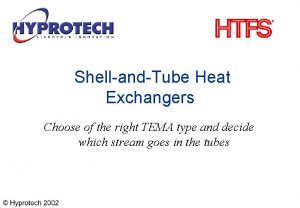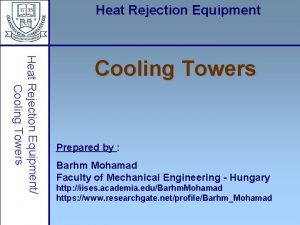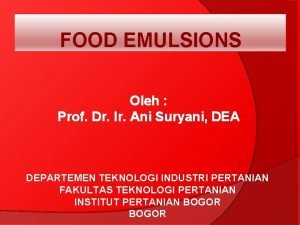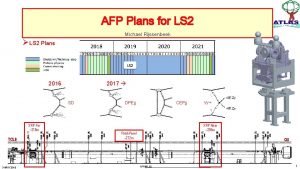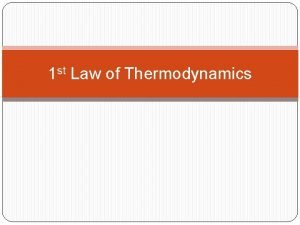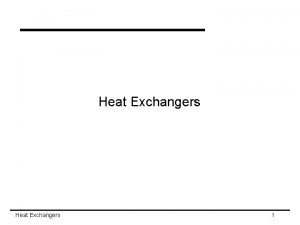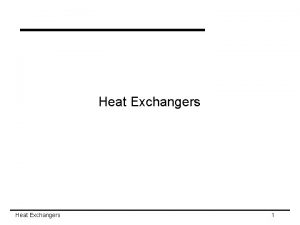HEAT PIPE HEAT EXCHANGERS Introduction to Heat Pipes







- Slides: 7

HEAT PIPE HEAT EXCHANGERS

Introduction to Heat Pipes Heat Pipe : Heat pipe is a self-contained passive energy recovery device. A heat pipe can transfer up to 1000 times more thermal energy, than copper, the best known conductor; that too with less than 57°C/mtr temperature drop. One of the amazing features of the heat pipes is that they have no moving parts and hence require minimum maintenance. They are completely silent and reversible in operation and require no external energy other than thermal energy they transfer. Heat pipes are ruggedly built and can withstand a lot of abuse. What is Heat Pipe : A traditional heat pipe is a hollow cylinder filled with a vaporizable liquid. The Heat Pipe functions as follows : A - Heat is absorbed in the evaporating section. B - Fluid boils to vapor phase. C - Heat is released from the upper part of cylinder to the environment; vapor condenses to liquid phase. D - Liquid returns by gravity to the lower part of cylinder (evaporating section). When heat is added to the evaporator section, the working fluid boils and converts into vapor absorbing latent heat. After reaching the condenser section, due to partial pressure build up, the vapor transforms back into liquid thus releasing latent heat. From the condenser section, heat is taken away by means of water cooling / air cooling with fins etc. The liquid condensate returns to the original position through the capillary return mechanism, completing the cycle. Due to very high latent heat of vaporization a large quantity of heat can be transferred.

Hot Gas to Air Heat Pipe Heat Exchangers : Typical finned Hot Gas to air Heat Pipe heat exchangers comprise of number of tubular gravity assisted finned Heat Pipes arranged in staggered pitch, depending upon the application. One of the advantages of the Heat Pipe Heat Exchanger is its ability to operate without cross contamination between the two streams. Use of Gravity Assisted Heat Pipe complies orientation evaporator above condenser for the Heat Pipe Heat Exchanger.

Hot Gas to Liquid Heat Pipe Heat Exchangers : This heat exchanger resembles Air to Air unit, only difference is liquid/water tank is provided at the condensation section to preheat liquid/water. Manor heat pipe heat exchanger can recover up to 85% of exhausted thermal energy. However under ideal conditions thermal efficiency of an economic system ranges between 55 to 70% and saves millions of BTUs year after year. Manor heat pipe heat exchangers as standard are suitable for air-to air heat recovery for a temperature range of - 10 o. C to + 260 o. C. With special materials of construction for the tube, the exchanger can be designed to extend the range to 427 o. C to 482 o. C

Heat Pipe Panel Cooler ( HPPC ) : Electrical and electronics control panels are normally made air tight to protect costly electronic and electrical components from dust. Inside components get overheated which leads to failure or mal-function. Control panel coolers extract heat from inside the panel without disturbing inside environment of panel.

Heat Pipe Dehumidifier ( HPD ) Heat Pipe Dehumidifiers ( HPD ) : In an air conditioning system, additional moisture is condensed out, as the air becomes colder and colder. The heat pipe is designed to have one section in the warm incoming stream and the other in the cold outgoing stream. By transferring the heat from the warm return/incoming air to the cold outgoing supply air, the heat pipes create the double effect of pre-cooling the air before it goes to the evaporator and then re-heating it immediately. This lowers the cooling load, evaporating temperature and heating load. Activated by temperature difference and therefore consuming no energy, the heat pipe, due to its pre-cooling effect, allows the evaporator coil to operate at a lower temperature, increasing the moisture removal capability of the air conditioning system by 50 -100%. With lower relative humidity, indoor comfort can be achieved at higher thermostat settings, which results in net energy savings. Generally, for each 1 °C rise in thermostat setting, there is a 3% savings in electricity cost. In addition, the precooling effect of the heat pipe allows the use of a smaller compressor.

Heat Pipe Applications Annealing furnaces • • • • Bakery Oven Boiler Brick Kiln Chemical fluid bed dryer Dehumidifier Epoxy coating curing Oven Foundry hot blast Fume scrubber Heater flue gas Heat treatment furnace Humber dryer Plastic laminate dryer Print dryer Reverberatory furnace Solvent boil off oven Spray dryer Textile cloth finishing oven Tanter frame textile drying oven Tumble dryer Veneer dryer etc.

